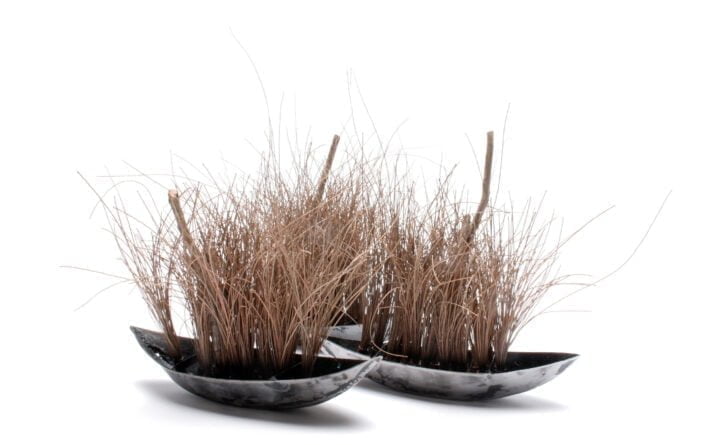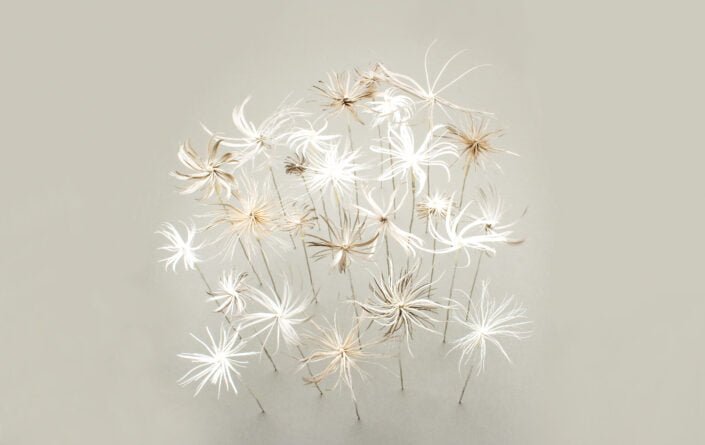Jan Learmonth
Along the river, eons of weather sculpts fragile limestone cliffs that are home to birds and precarious plants. Amongst reflections and shadowed reeds, are places for hunting on long legs with javelin beaks. Creatures are swirls with flashing scales that live below.
The suspended vessel, once floating, is now in the air with the detritus of the water-life clinging to its exposed underside. Its interior apse, like the river curve, is embossed with the textures and shapes of netted wood and spidery web. The small canoe shapes with Casuarina leaves, are a dry swamp looking across the reeds. Mapping our river journey, I have incorporated the forms of landings and
canoes, rock faces and pine forests, spider’s nests and shells, together with the Red-tailed Black-Cockatoo and other bird-life sustained by the river and its estuary.
Jan Learmonth
Jan Learmonth’s work navigates the loose weave of the Glenelg River and Gorge and also engages ideas of forest, estuary and ocean. In forms sculpted from weathered wood, metal, and found materials, she imaginatively translates this journey in all its changing moods and rhythms. Her works gather the elements of air, water and earth to comment on the environment and how it is being used. The river’s fragile countenance is like a manuscript in process – one in which we read signs of struggle. The visual strength and simple construction of Learmonth’s forms, combined with a playfully delicate handling, create a sense of the precarious, and sometimes uplifting, relationship between people and land.
Interview with Jan Learmonth
Why did you choose to be involved in the Great South West Walk Art Project?
I was invited to participate when another member had to pull out – just fortunate to be in the right place at the right time.
Did you have any preconceived ideas or plans for your work before embarking on the Walk? I went with an open mind but had visited the area before so knew of the landscape and biodiversity of the national park. Also to be with other artists put another perspective on the idea and the excitement of how it would evolve.
How would you describe your artistic practice from concept to making?
Once I had decided on a shape, i.e. boat, the pieces just grew from there. Just kept the landscape/river environment in mind through the process.
The Glenelg River and Gorge feature strongly in your work in the exhibition. What is it about the River that inspired you?
Paddling rivers – flat ones that is – is an activity I have enjoyed for years. The visual perspective when on the water is always rewarding and stimulating and so different from standing [and] looking from the bank; a feeling of being part of another world that can be moved through quietly. Life changes when in a low profile boat that is silent and needs only muesli for breakfast to help power it along!
When did you start making work for this exhibition? When did it stop being ‘note taking’ and become ‘making’?
General note taking and the idea of constructing boat shapes started gently when near and on the river but there was time enough to think of the construction on the trip home, which took a couple of days. As soon as I reached the shed work began.
What did you hope to capture in your work? I hope a feeling of adventure and discovery. Plus the thought of the drought impact – especially on [the] river, lakes and wetlands. [And] to be immensely appreciative of the beauty and wonderful diversity a health waterway can bring to an environment.
What were the major challenges you faced on the Walk?
To keep on the job with the camera. What do you hope the viewer will take away from your work and the exhibition? I hope people who view the exhibition leave with added knowledge of the area and will visit and enjoy [it] at some stage, with a small and gentle footstep.
Jan Learmonth is represented by Gallery 101 (Melbourne)
2007Along the river, eons of weather sculpts fragile limestone cliffs that are home to birds and precarious plants. Amongst reflections and shadowed reeds, are places for hunting on long legs with javelin beaks. Creatures are swirls with flashing scales that live below.
The suspended vessel, once floating, is now in the air with the detritus of the water-life clinging to its exposed underside. Its interior apse, like the river curve, is embossed with the textures and shapes of netted wood and spidery web. The small canoe shapes with Casuarina leaves, are a dry swamp looking across the reeds. Mapping our river journey, I have incorporated the forms of landings and
canoes, rock faces and pine forests, spider’s nests and shells, together with the Red-tailed Black-Cockatoo and other bird-life sustained by the river and its estuary.
Jan Learmonth
Jan Learmonth’s work navigates the loose weave of the Glenelg River and Gorge and also engages ideas of forest, estuary and ocean. In forms sculpted from weathered wood, metal, and found materials, she imaginatively translates this journey in all its changing moods and rhythms. Her works gather the elements of air, water and earth to comment on the environment and how it is being used. The river’s fragile countenance is like a manuscript in process – one in which we read signs of struggle. The visual strength and simple construction of Learmonth’s forms, combined with a playfully delicate handling, create a sense of the precarious, and sometimes uplifting, relationship between people and land.
Interview with Jan Learmonth
Why did you choose to be involved in the Great South West Walk Art Project?
I was invited to participate when another member had to pull out – just fortunate to be in the right place at the right time.
Did you have any preconceived ideas or plans for your work before embarking on the Walk? I went with an open mind but had visited the area before so knew of the landscape and biodiversity of the national park. Also to be with other artists put another perspective on the idea and the excitement of how it would evolve.
How would you describe your artistic practice from concept to making?
Once I had decided on a shape, i.e. boat, the pieces just grew from there. Just kept the landscape/river environment in mind through the process.
The Glenelg River and Gorge feature strongly in your work in the exhibition. What is it about the River that inspired you?
Paddling rivers – flat ones that is – is an activity I have enjoyed for years. The visual perspective when on the water is always rewarding and stimulating and so different from standing [and] looking from the bank; a feeling of being part of another world that can be moved through quietly. Life changes when in a low profile boat that is silent and needs only muesli for breakfast to help power it along!
When did you start making work for this exhibition? When did it stop being ‘note taking’ and become ‘making’?
General note taking and the idea of constructing boat shapes started gently when near and on the river but there was time enough to think of the construction on the trip home, which took a couple of days. As soon as I reached the shed work began.
What did you hope to capture in your work? I hope a feeling of adventure and discovery. Plus the thought of the drought impact – especially on [the] river, lakes and wetlands. [And] to be immensely appreciative of the beauty and wonderful diversity a health waterway can bring to an environment.
What were the major challenges you faced on the Walk?
To keep on the job with the camera. What do you hope the viewer will take away from your work and the exhibition? I hope people who view the exhibition leave with added knowledge of the area and will visit and enjoy [it] at some stage, with a small and gentle footstep.
Jan Learmonth is represented by Gallery 101 (Melbourne)
2007



